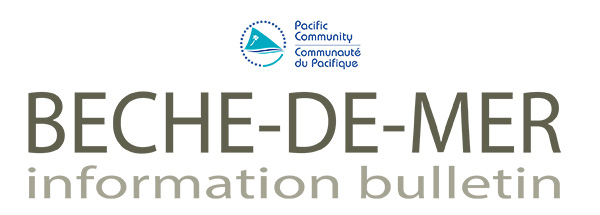
Group Coordinator and Bulletin Editor
Production
Pacific Community, Fisheries Aquaculture and Marine Ecosystems Division, Information Section, SPC, BP D5, 98848 Noumea Cedex, New Caledonia.
Produced with financial assistance from the Australian Government, the European Union, France and the New Zealand Aid Programme.
Editorial
The 44th issue of the SPC Beche-de-Mer Information Bulletin includes nine original articles and scientific observations from around the world.
The first article by Burgy and Purcell (p. 4) presents the results of an aquaculture programme in French Polynesia on the white teatfish, Holothuria fuscogilva, and black teatfish, H. whitmaei. The programme aims at developing commercial-scale aquaculture for this promising sector whose products are intended for international markets, particularly in Asia.
The next article, presented by Scott and colleagues (p. 22), documents cases of skin ulceration diseases among individuals of a laboratory-held Canadian population of Cucumaria frondosa by comparing disease-associated symptoms with those previously described in the literature and exploring the potential co-incident causative factors.
Chammem (p. 27) provides an analysis of sea cucumber trading in Tunisia, emphasising the targeted species in the central Mediterranean Sea. Drawing insights from a diverse range of sources, it offers a detailed overview of the existing state of the sea cucumber trade in the region.
The two next articles concern Actinopyga species. Morejhon and Argyle (p. 31) provide the first observations of Actinopyga cf. flammea from Cook Islands, while Parrish (p. 34) makes points out a strange V-shaped sea cucumber morphology where a living adult Actinopyga varians in Cook Islands has a partial longitudinal split starting from the posterior end.
We then have the first report of Holothuria spinifera on the mid-west coast of Western Australia by Murphy and Hart (p. 35).
It is rare to have information from private companies practicing sea cucumber aquaculture. Eeckhaut (p. 39) “gives the floor” to sea cucumber aquaculture farmers and people employed by the company Indian Ocean Trepang to give some details on how sea cucumber farming works in Madagascar through the perspective of the private sector.
Also coming from Madagascar, Lavitra and colleagues (p. 48) explore local perceptions of the socioeconomic and environmental impacts of sea cucumber farming in the southwestern region during surveys of 298 households, of which 69 are actively engaged in sea cucumber farming.
Corbel and colleagues (p. 59) report of a study study that gave the first large-scale mapping (km scale) of the distribution of holothurian communities on reef flats of La Saline/L’Hermitage, Reunion Island. Fourteen different species of sea cucumbers were surveyed, three of which were dominant: Holothuria leucospilota, Holothuria atra and Stichopus chloronotus.
Finally, Cauvin (p. 65) shares some observations of the retail price of the sea cucumber Apostichopus japonicus at stalls in the two main fish sales markets in Tokyo, Japan.
Also included in this issue are various communications (p. 68), including those published on the web. Abstracts related sea cucumbers at the 11th European Conference on Echinoderms (Lyon, France) are reproduced on pages 68 to 73. Seven books concerning the biology, ecology or aquaculture of sea cucumbers have been published in recent months (p. 81). We mention the 17th International Echinoderm Conference that will take place in the Canary Islands as well as the opening in September of a new training position in Artisanal Mariculture Sciences and Village Farming. Congratulations to Joséphine Pierrat who presented her thesis at the University of Réunion.

